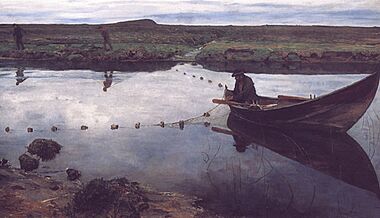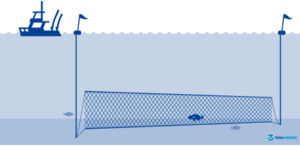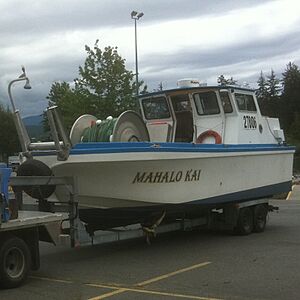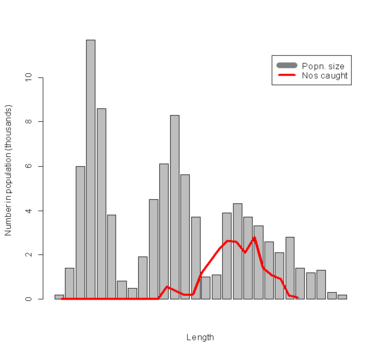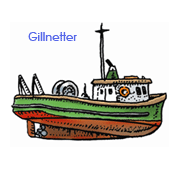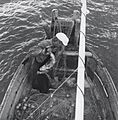Gillnetting facts for kids
Gillnetting is a way of fishing that uses special nets called gillnets. These nets hang straight up and down in the water. They have floats at the top, like corks, to keep them floating. The bottom of the net has weights, often made of lead, to keep it stretched out. A gillnet is usually set in a straight line in the water.
Fish get caught in gillnets in a few ways:
- They get stuck by their body in the net's holes.
- They get caught by their gills as they try to swim through.
- They get tangled by their teeth, fins, or other parts.
Most fish have gills. When a fish swims into a net, it might get its head through the mesh, but not its whole body. As it tries to get free, the net slips behind its gill covers, trapping it.
Gillnets are very good at catching fish. Because of this, their use is carefully watched and controlled by fishing rules. Things like the size of the net's holes, how strong the net is, and how long and deep it can be are all regulated. This helps to avoid catching too many fish or other animals that are not meant to be caught. For example, in many salmon fisheries, very few other animals are caught by mistake.
A fishing boat that uses gillnets is called a gillnetter. If the boat puts its net out from the front (the bow), it's called a bowpicker. If it puts the net out from the back (the stern), it's a sternpicker. Gillnets are different from seine nets. Seine nets are like big walls that trap fish in an enclosed space, while gillnets catch fish directly as they try to swim through.
Contents
History of Gillnetting
People have used gillnets for a very long time. We know this from old discoveries in places like the Middle East. In North America, Native American fishermen used canoes made of cedar wood and nets made from natural plant fibers. They used stones as weights and pieces of wood as floats. This made the nets hang straight in the water. They would set nets from the shore or between two boats. Today, Native fishers in places like the Pacific Northwest, Canada, and Alaska still use gillnets to catch salmon and steelhead.
Both nets that drift freely and nets that are set in one place have been used by people all over the world for ages. In Japan, there is a lot of history about fishing, including gillnetting, going back hundreds of years. Fishermen in the Shetland Islands, who have Viking roots, used gillnets for herring, just like in Norway. Many Norwegian fishermen came to the Columbia River in the late 1800s to fish for salmon because they knew how to use gillnets. Fishermen in Wales and England also used gillnets to catch Atlantic salmon in rivers for centuries.
Gillnetting was an early fishing method in early America, used for fish like Atlantic salmon. Fishermen from Europe brought different ways of using these nets to the growing salmon fisheries on the Columbia River starting in the 1860s. Their boats were usually about 7.6 meters (25 feet) long and were powered by oars. Some also had small sails. Later, steam-powered ships would take these smaller boats to their fishing spots. By the 1930s, boats with gas engines became popular, and the old row-sail boats mostly disappeared.
In 1931, a man named Laurie Jarelainen invented the first powered drum. This is a round device on the side of the boat that pulls in the nets much faster. This invention, along with faster gas-powered boats, changed fishing. Fishermen could now go to new areas they couldn't reach before.
During World War II, navigation and communication tools for boats got much better and smaller. These tools became easier for regular fishermen to get. This meant boats could travel further and move around more easily. It also made fishing more competitive, as fishermen had to buy newer boats and equipment to keep up.
In the 1960s, new materials like nylon were used to make fishing nets. These new nets were cheaper, easier to use, lasted longer, and needed less care than nets made from natural fibers. Also, nylon nets are almost invisible in the water. This meant they caught more fish than older nets.
Nylon is very strong and lasts a long time. If a nylon net gets lost in the ocean, it can keep catching fish for many years. This is called "ghost fishing" and is a problem for the environment. Using materials that break down over time for the floats can help reduce this problem. However, some lost nets might break apart quickly from waves, while others might get covered in seaweed, making them less effective or even turning them into a small home for tiny fish.
In the 1980s, many fishing fleets used these nets to catch tuna. While gillnets are good at catching fish of a certain size, they also accidentally catch many other animals, like whales and dolphins. For example, in one tuna fishery, one dolphin was caught for every 1.7 to 4.0 tonnes of tuna. This is a much higher rate than in other types of tuna fishing.
Scientists also use different kinds of gillnets to study fish populations. Some special gillnets can even help scientists find out at what depth fish are swimming.
Rules for Gillnetting
Many countries have rules about gillnetting in their waters. The United Nations General Assembly asked for an end to all "large-scale pelagic drift-net fishing" in international waters by the end of 1992.
In the United States, owning gillnets is illegal in some states and very strictly controlled in others. For example, in Oregon, voters decided in 2012 to allow commercial gillnet fishing to continue on the Columbia River. The Columbia River Basin has an agreement until 2017 to study how fish are caught, including with gillnets. After that, they will decide on new rules.
Rules for gillnetting can change from place to place. In Minnesota, the fishing season and net types depend on the county and lake. In Virginia, the rules for gillnetting seasons and net sizes vary by river and month.
There have been ideas to stop drift gillnet fishing if too many other animals, like dolphins and sea turtles, are caught by mistake. In 2014, lawmakers in California tried to ban gillnet fishing. This effort was paused in mid-2017.
Since 1996, commercial fishing boats from the United States need a permit to fish on the high seas. They also have to keep records of all their fishing activities.
In 2017, a new bill was suggested to improve how driftnets are managed. This bill aims to ban very large nets and encourage other fishing methods that catch fewer unwanted animals. It also suggests helping fishermen who stop using large nets.
How Gillnets Catch Fish Selectively
Gillnets have a bottom line with weights and a top line with floats. By changing how many floats and weights are used, the net can be set to fish at any depth in the water. In commercial fishing, all the holes in a gillnet are the same size. Fish that are smaller than the holes can swim right through. Fish that are too big to get their heads through the holes are not caught. This means gillnets can target a specific size of fish. This is different from other nets like trawls, which catch all fish larger than the net's holes.
Catching Salmon
Gillnets are still an important way to catch salmon in places like Alaska, British Columbia, Washington, and Oregon. In the lower Columbia River, fishermen have found ways to catch only certain salmon, like those from hatcheries, using small-holed gillnets called tangle nets. Salmon that are not from hatcheries must be released. Fishing managers believe that most of these released salmon survive.
One problem with catching only certain sizes of fish is that it can affect how fish populations reproduce. If only the biggest fish are caught, then smaller, younger fish might be the ones left to have babies. A study in 2009 looked at salmon in Bristol Bay for 59 years. It found that the biggest female salmon were caught most often. This meant that smaller, younger fish were more likely to get past the nets and reproduce. The study also found that the average size of salmon caught was bigger than the salmon that escaped to lay eggs. This meant the female salmon that escaped laid fewer eggs. If a salmon gets caught in a gillnet but escapes, it can get hurt. These injuries can make it harder for them to reproduce. A study found that 11–29% of salmon were hurt by gillnets, and about half of those hurt fish were not expected to reproduce.
Gillnets can sometimes be a topic of debate, especially among people who fish for fun. They argue that gillnets are not good for salmon fishing. These arguments are often about who gets to catch the fish, not about protecting the fish. However, most salmon fisheries, especially in North America, are carefully managed to protect fish populations. Managers continue to allow gillnets to be used in these fisheries.
Catching Swordfish
Gillnets are also used in the deep sea to catch swordfish. However, some swordfish fisheries, like those in California, catch many other animals by mistake. For example, only 12% of the catch might be swordfish, while up to 68% could be other animals that are thrown back into the sea.
Other Fishing Methods
Because gillnets can be very selective, scientists are looking into other ways to catch fish. Some reports suggest that purse seine nets are very effective, but there is not much information on how well they can selectively catch hatchery-raised salmon. A 10-year study compared purse seines and tangle nets for catching hatchery salmon. The study found that purse seines had a higher survival rate for released fish and caught more fish overall than tangle nets. One biologist reported that using purse seines, they caught over 3,000 hatchery salmon and released over 2,000 wild salmon with very few deaths. Tangle nets were less effective and had a higher death rate for released fish. Researchers believe that using recovery boxes and checking nets more often could lower the death rates. While these selective methods work, people still need to accept these new ways of fishing.
Studies have also looked at ways to reduce the number of birds accidentally caught in coastal fisheries, which is estimated to be around 400,000 each year. Three ideas could reduce bird bycatch by up to 75%:
- Changing the gear: Adding visual devices to the top of the net so birds can see them.
- Opening fisheries based on bird numbers: Deciding whether to set nets based on how many birds are around.
- Time-of-day rules: Since birds are often caught at dawn and dusk, but fish are mostly caught at dawn, restricting fishing times could help.
For marine mammals, experiments have shown that using "pingers" (devices that make sounds) on nets greatly reduces the number of accidental catches. One study found that nets with pingers caught 12 times fewer dolphins, 4 times fewer other whales and dolphins, and 3 times fewer seals and sea lions.
Types of Gillnets
The FAO (Food and Agriculture Organization) groups gillnet types like this:
Set Gillnets
Set gillnets are single walls of netting that stand upright in the water. They have floats on the top line and weights on the bottom line. The floats are usually small, egg-shaped, or cylinder-shaped plastic pieces. The weights are often lead. The bottom line can also be a heavy rope that doesn't need extra weights. These nets are set on the bottom of the sea or a little above it. They are held in place with anchors or weights at both ends. By changing how they are designed, these nets can catch fish near the surface, in the middle of the water, or on the bottom.
On small boats, people handle these nets by hand. Larger boats use machines to pull the nets in. Set gillnets are used all over the world in both rivers and oceans. They are popular with small-scale fishermen because they don't need special equipment and are cheap to use compared to the amount of fish caught.
Encircling Gillnets
Encircling gillnets are set vertically in shallow water, with the floats staying on the surface. They are used to surround fish. Small boats or canoes can be used to set the net around a group of fish. Once the fish are surrounded, fishermen shout and splash the water to scare the fish. This makes the fish try to escape and get caught in the net. This method has little bad impact on the environment. The net is set and pulled back quickly, and the fish are usually alive. This means unwanted fish can be put back into the sea. Groups of small-scale fishermen often use encircling gillnets, and they don't need much other equipment.
Combined Gillnets-Trammel Nets
This type of net is set on the bottom and has two parts:
- The top part is a regular gillnet, which can catch fish that swim in the middle of the water or near the bottom.
- The bottom part is a trammel net, which is designed to tangle fish that live on the bottom.
These combined nets are kept upright by floats and weights. They are left in the water for a certain time, depending on the type of fish being caught, then pulled onto the boat. In the past, people pulled these nets by hand, especially on smaller boats. Now, machines are often used. The fish caught are removed by hand. One concern with these nets is "ghost fishing" if they get lost, and also catching diving seabirds by mistake. These combined nets were first used in the Mediterranean Sea.
Drift Nets
A drift net is made of one or more net sections joined together. They are left to drift freely with the ocean currents, usually near the surface or just below it. Floats on the top line and weights on the bottom line keep them upright. Drift nets stay connected to the fishing boat, which is called a driftnetter.
Drift nets are often used to catch fish that swim in schools, like herring and sardines. They also catch larger fish like tuna, salmon, and squid. Machines are usually used to set and pull in driftnets. In developing countries, most nets are still pulled in by hand. The size of the net's holes is very good at catching fish of a specific size. Drift nets use less fuel compared to other fishing gear. However, a big concern with these nets is accidentally catching animals that are not targeted, such as marine mammals, seabirds, and sometimes turtles. The United Nations banned the use of drift nets longer than 2.5 kilometers (1.5 miles) in international waters in 1991. Before this ban, some drift nets were as long as 60 kilometers (37 miles)! But there are still worries about people breaking these rules.
Gillnets and Entangling Nets
The tangle net, also called a tooth net, was first developed in British Columbia, Canada. It was made for fishing where certain fish need to be released unharmed. Tangle nets have smaller holes than regular gillnets. They are designed to catch fish by their nose or jaw. This allows unwanted fish to be released without harm. For example, tangle nets used for spring Chinook salmon have a mesh size of about 10.8 centimeters (4 1/4 inches). They use short net lengths and are left in the water for short times to keep the fish in good condition.
Tangle nets are typically used when it's important to release certain fish, like wild fish, unharmed. For example, if fish that still have their adipose fins (which usually means they are wild) must be returned to the water, tangle nets are used. These nets are often used with a "live recovery box." This box acts like a special chamber where unmarked fish that look tired or stressed can recover before being released back into the water.
Images for kids


